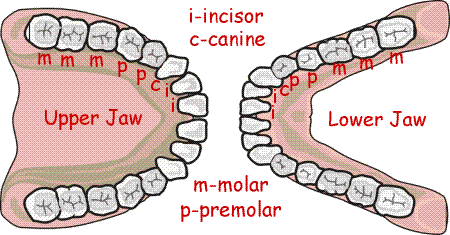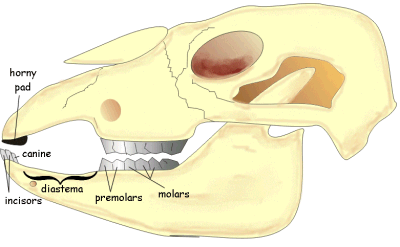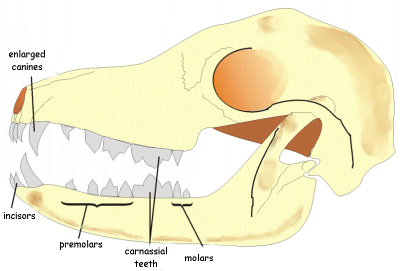Dentition
There are different types of teeth, each specially shaped to perform a particular job.
- Incisor - A broad flat sharp tooth found at the front of the mouth. Designed for biting and cutting food.
- Canine - A sharp pointed tooth for piercing flesh and tearing.
- Pre-molar & molar - A broad flat tooth with many cusps. Its rough surface is used for crushing, grinding and chewing food.
The teeth are arranged in a certain way. The arrangement is known as dentition. Adult humans should have 32 teeth, 16 in the upper jaw and 16 in the lower jaw. There are two incisors, a canine, two premolars and three molars on each side of each jaw. This can be written in a simpler way.

The shows how many teeth of each type can be found on each side of the jaw. The upper figures are for the upper jaw and the lower figures are for the lower jaw.

The shapes of teeth can be modified to cope with particular diets. This can be shown by looking at the teeth of a herbivore and a carnivore.
Herbivore

A sheep's skull
Sheep do not have any top incisors. Instead they have a horny pad against which the incisors of the lower jaw cut against. The incisors and the canine are chisel shaped for cutting the tough plant material. There is a gap before the premolars and the molars called the diastema. This allows the sheep's tongue to protrude through the side of the mouth, wrap around the long grass and pull it into the mouth.
The premolars and molars wear down quite quickly as plant cell walls are very tough. The teeth need to keep growing. The enamel on the tops of these teeth actually wears away to reveal the dentine below. As the two wear down at different rates the surface of the teeth is very rough with ridges of enamel and dentine. This rough surface helps to grind the plant material. The jaw of the sheep allows some sideways movement so that it can chew in a circular movement.
Carnivore

A dog's skull
A dog's teeth is designed to kill live prey. The sharp incisors are designed to bite off flesh. The Long canine teeth pierce the flesh to grip the struggling prey as it being killed. The premolars and molars are jagged and quite thin. They teeth of the upper and lower jaw's overlap so when they jaws snap they act like scissors.
The dog's jaw will not allow sideways movement for chewing. This could lead to dislocation when the prey struggled. The dog, like other meat eaters has to throw its head back to force the food onto the molars and premolars. The mouth then snaps shut slicing the food.
